sensor DATSUN 210 1979 Service Manual
[x] Cancel search | Manufacturer: DATSUN, Model Year: 1979, Model line: 210, Model: DATSUN 210 1979Pages: 548, PDF Size: 28.66 MB
Page 24 of 548
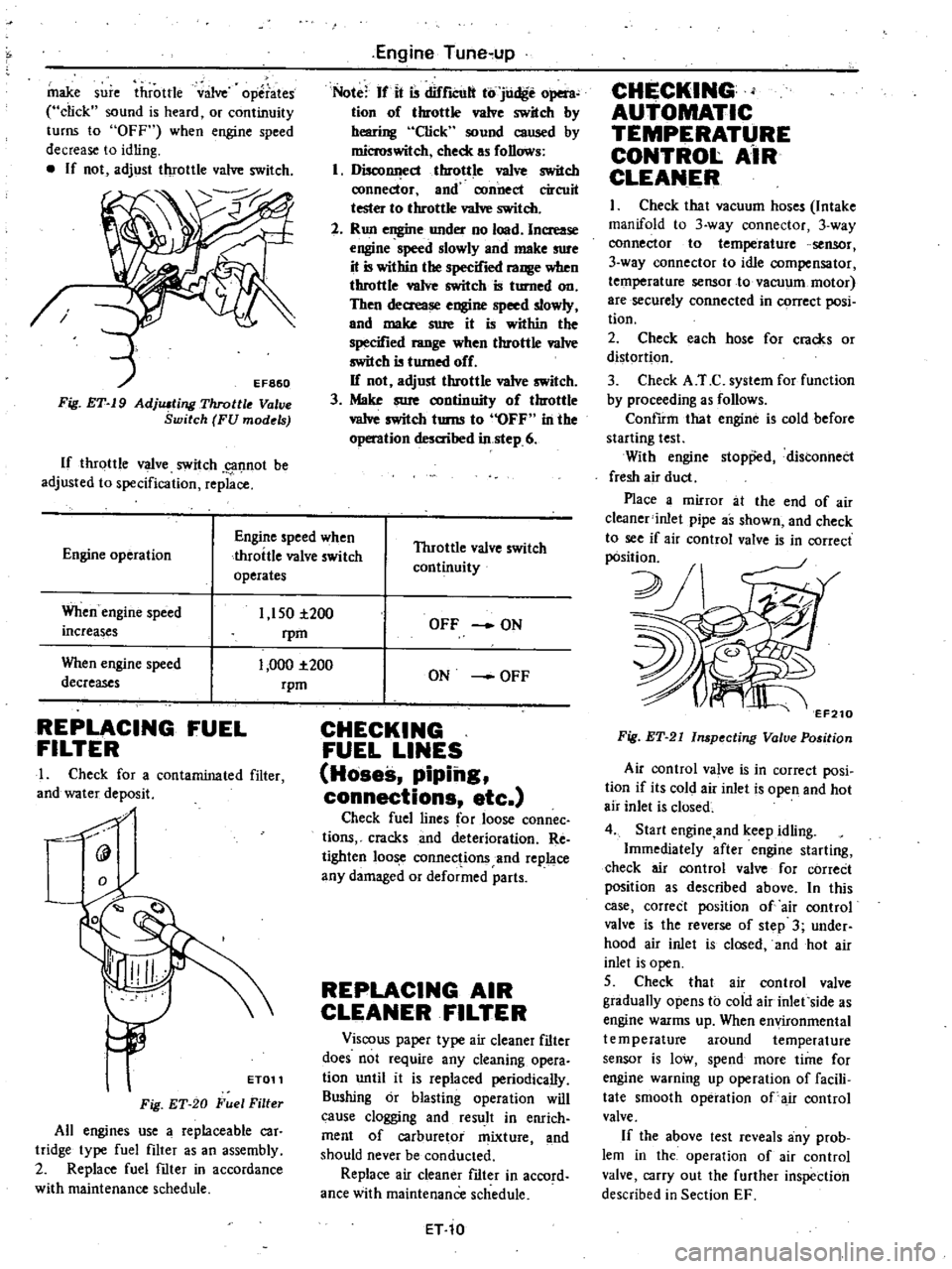
make
sure
throttle
valve
operates
click
sound
is
heard
or
continuity
turns
to
OFF
when
engine
speed
decrease
to
idling
If
not
adjust
throttle
valve
switch
Fig
ET
19
AdjlUting
Throttle
V
ve
Switch
FU
models
If
throttle
valve
switch
g1f1not
be
adjusted
to
specification
replace
Engine
Tune
up
Note
If
it
is
difrlCUlt
to
judge
open
tion
of
throttle
valve
switch
by
hearing
Click
sound
caused
by
microswitch
check
as
follows
1
DiscollI
ecl
throttle
va1ve
switch
ronnector
and
connect
circuit
tester
to
throttle
va1ve
switch
2
Run
engine
under
no
load
Increase
engine
speed
slowly
and
make
sure
it
is
within
the
specified
range
when
throttle
valve
switch
is
turned
on
Then
decrease
engine
speed
slowly
and
make
sure
it
is
within
the
specified
range
when
throttle
va1ve
switch
is
turned
off
If
not
adjust
throttle
valve
switch
3
Make
sure
continuity
of
throttle
vaIve
switch
turns
to
OFF
in
the
operation
desaihed
in
step
6
Engine
operation
Engine
speed
when
throttle
valve
switch
operates
Throttle
valve
switch
continuity
When
engine
speed
increases
1
150
i200
rpm
1
000
1
200
rpm
When
engine
speed
decreases
REPLACING
FUEL
FILTER
I
Check
for
a
contaminated
filter
and
water
deposit
0
9
ET011
Fig
ET
20
Fuel
Filter
All
engines
use
a
replaceable
car
tridge
type
fuel
filter
as
an
assembly
2
Replace
fuel
filter
in
accordance
with
maintenance
schedule
OFF
ON
ON
OFF
CHECKING
FUEL
LINES
Hoses
piping
connections
etc
Check
fuel
lines
for
loose
connec
tions
cracks
and
deterioration
Re
tighten
loose
connections
and
replace
any
damaged
or
deformed
parts
REPLACING
AIR
CLEANER
FILTER
Viscous
paper
type
air
cleaner
filter
does
not
require
any
cleaning
opera
tion
until
it
is
replaced
periodically
Sushing
or
blasting
operation
will
cause
clogging
and
result
in
enrich
ment
of
carburetor
mixture
and
should
never
be
conducted
Replace
air
cleaner
filter
in
accord
ance
with
maintenance
schedule
ET
10
CHECKING
AUTOMATIC
TEMPERATURE
CONTROl
AiR
CLEANER
I
Check
that
vacuum
hoses
Intake
manifold
to
3
way
connector
3
way
connector
to
temperature
sensor
3
way
connector
to
idle
compensator
temperature
sensor
to
vacuum
motor
are
securely
connected
in
C9rrect
posi
tion
2
Check
each
hose
for
cracks
or
distortion
3
Check
A
T
C
system
for
function
by
proceeding
as
follows
ConfIrm
that
engine
is
cold
before
starting
test
With
engine
stopp
d
distonnect
fresh
air
duct
Place
a
mirror
at
the
end
of
air
c1eaner
inlet
pipe
as
shown
and
check
to
see
if
air
control
valve
is
in
correct
pOsition
2J
v
7
EF210
Fig
ET
21
Inspecting
Valve
Position
Air
control
va
ve
is
in
correct
posi
tion
if
its
cold
air
inlet
is
open
and
hot
air
inlet
is
closed
4
Start
engine
and
keep
idling
Immediately
after
engine
starting
check
air
control
valve
for
correCt
position
as
described
above
In
this
case
correct
position
of
air
control
valve
is
the
reverse
of
step
3
under
hood
air
inlet
is
closed
and
hot
air
inlet
is
open
5
Check
that
air
control
valve
gradually
opens
to
cold
air
inlet
side
as
engine
warms
up
When
environmental
temperature
around
temperature
sensor
is
low
spend
more
time
for
engine
warning
up
operation
of
facili
tate
smooth
operation
of
air
control
valve
If
the
above
test
reveals
any
prob
lem
in
the
operation
of
air
control
valve
carry
out
the
further
inspection
described
in
Section
EF
Page 25 of 548
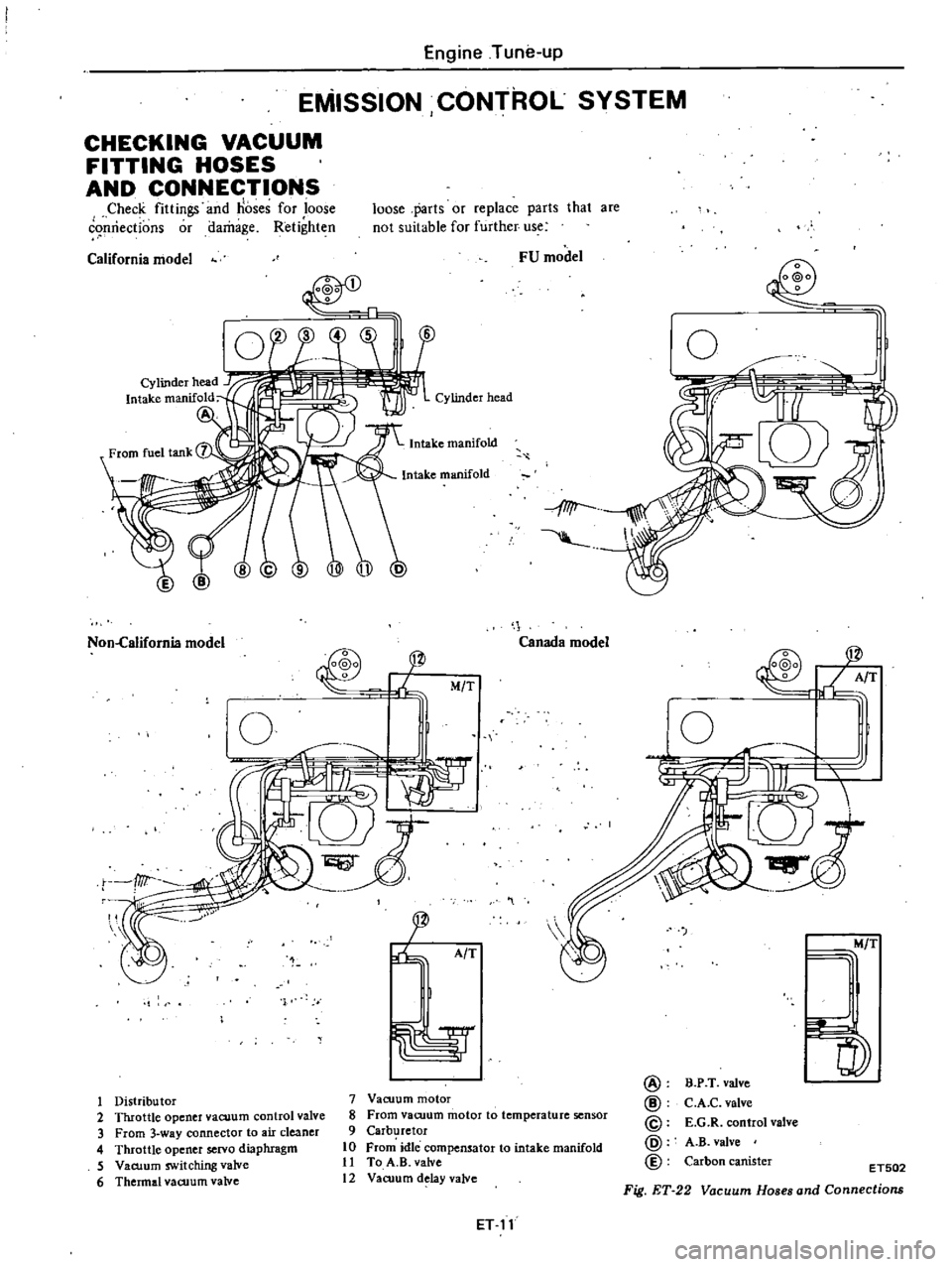
Engine
Tune
up
EMISSION
CONTROL
SYSTEM
CHECKING
VACUUM
FITTING
HOSES
AND
CONNECTIONS
Check
fittings
and
hoses
for
ioose
cqnriections
or
damage
Retighten
loose
parts
or
replace
parts
that
are
not
suitable
for
further
use
California
model
FU
model
w
fl11r
o
Intake
manifold
Non
California
model
q
Canada
model
@
T
J
I
M
T
r
T
r
o
p
1
o
1
J
1
Distributor
2
Throttle
opener
vaaJ
um
control
valve
3
From
3
way
connector
to
air
cleaner
4
Throttle
opener
servo
diaphragm
5
Vacuum
switching
valve
6
Thermal
v3roum
valve
7
Vacuum
motor
8
From
vacuum
motor
to
temperature
sensor
9
Carburetor
10
From
idle
compensator
to
intake
manifold
11
To
A
B
valve
12
Vacuum
d
lay
valve
@
@
@
@
@
B
P
T
valve
C
A
C
valve
E
G
R
control
valve
A
B
valve
Carbon
canister
M
T
l
Q2
A
T
ET502
Fig
ET
22
Vacuum
Hoses
and
Connections
ET
11
Page 32 of 548
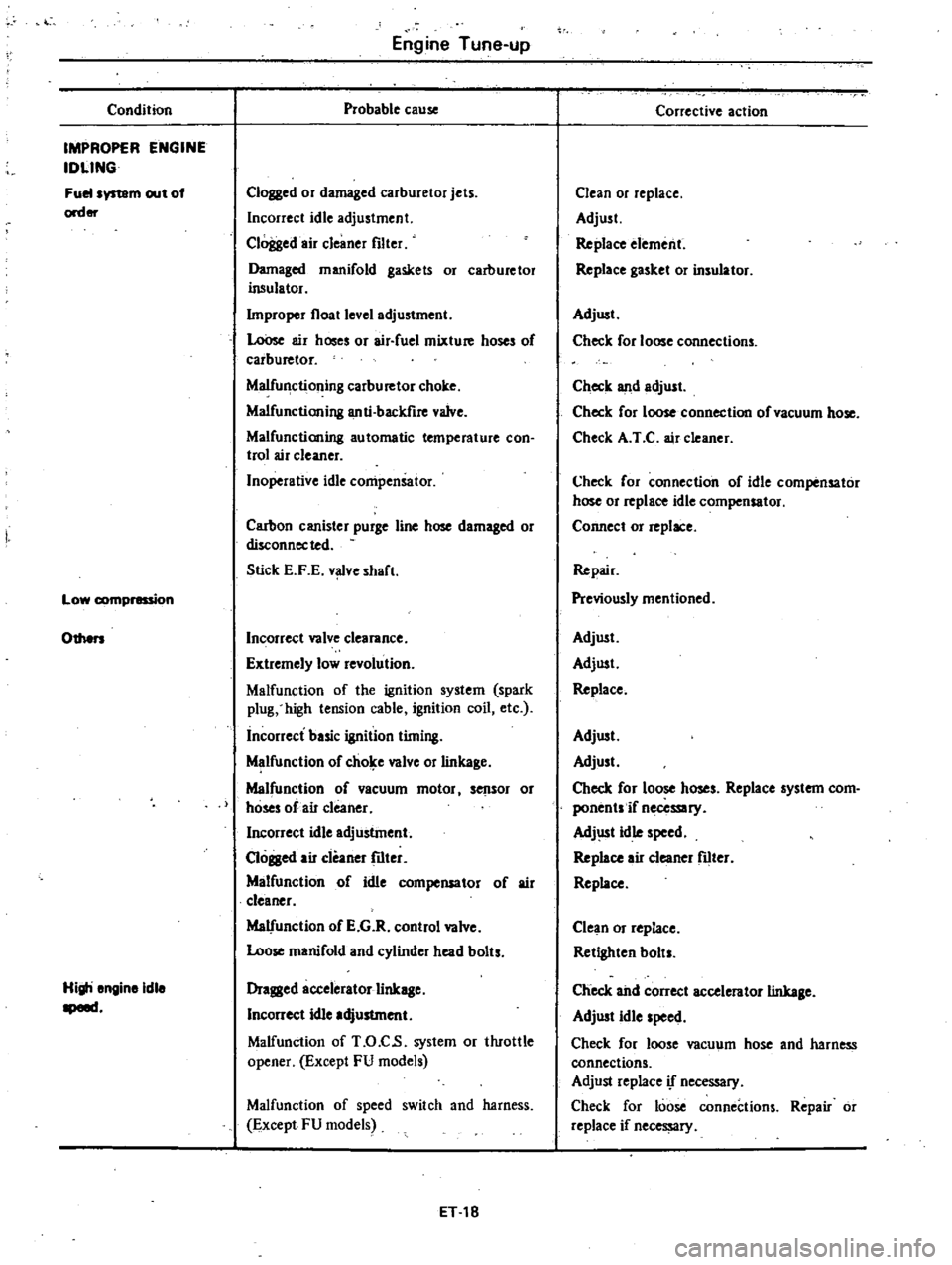
Condition
IMPROPER
ENGINE
IDLING
Fuelsystam
out
of
order
Low
1
ion
Engine
Tune
up
Probable
cause
Clogged
or
damaged
carburetor
jets
Incorrect
idle
adjustment
Clogged
air
cleaner
filter
Damaged
manifold
gaskets
or
carburetor
insulator
bnproper
float
level
adjustment
LoOse
air
hoses
or
air
fuel
mixture
hoses
of
carburetor
Malfunctioning
carburetor
choke
Malfunctioning
anti
backfire
valve
Malfunctioning
automatic
temperature
con
trol
air
cleaner
Inoperative
idle
compensator
Carbon
canister
purge
line
hose
damaged
or
disconnected
Stick
E
F
E
v
ve
shaft
Othen
Incorrect
valve
clearance
Extremely
low
revolution
Malfunction
of
the
ignition
system
spark
plug
high
tension
cable
ignition
coil
etc
incorrect
basic
ignition
timing
Malfunction
of
chol
e
valve
or
linkage
Malfunction
of
vacuum
motor
sensor
or
hoses
of
air
cleaner
Incorrect
idle
adjustment
Cloged
air
cleaner
fIIter
Malfunction
of
idle
compensator
of
air
cleaner
Malfunction
of
E
G
R
control
valve
Loose
manifold
and
cylinder
head
bolts
Higli
engine
idle
opem
Dragged
accelerator
linkage
Incorrect
idle
adjustment
Malfunction
of
T
O
C
s
system
or
tluottle
opener
Except
FU
models
Malfunction
of
speed
switch
and
harness
Except
FU
models
ET
18
Corrective
action
Clean
or
replace
Adjust
Replace
element
Replace
gasket
or
insulator
Adjust
Check
for
loose
connections
Check
lUId
adjust
Check
for
loose
connection
of
vacuum
hose
Check
A
I
C
air
cleaner
Check
for
connection
of
idle
compensator
hose
or
replace
idle
compensator
Connect
or
replace
Repair
Previously
mentioned
Adjust
Adjust
Replace
Adjust
Adjust
Check
for
loose
hoses
Replace
system
com
ponentsif
necessary
Adj
lSt
idle
speed
Replace
air
cleaner
filter
Replace
Clean
or
replace
Retighten
bolts
Check
ahd
correct
accelerator
linkage
Adjust
idle
speed
Check
for
loose
vacuum
hose
and
harness
connections
Adjust
replace
if
necessary
Check
for
loose
connections
Repair
or
replace
if
necessary
Page 87 of 548
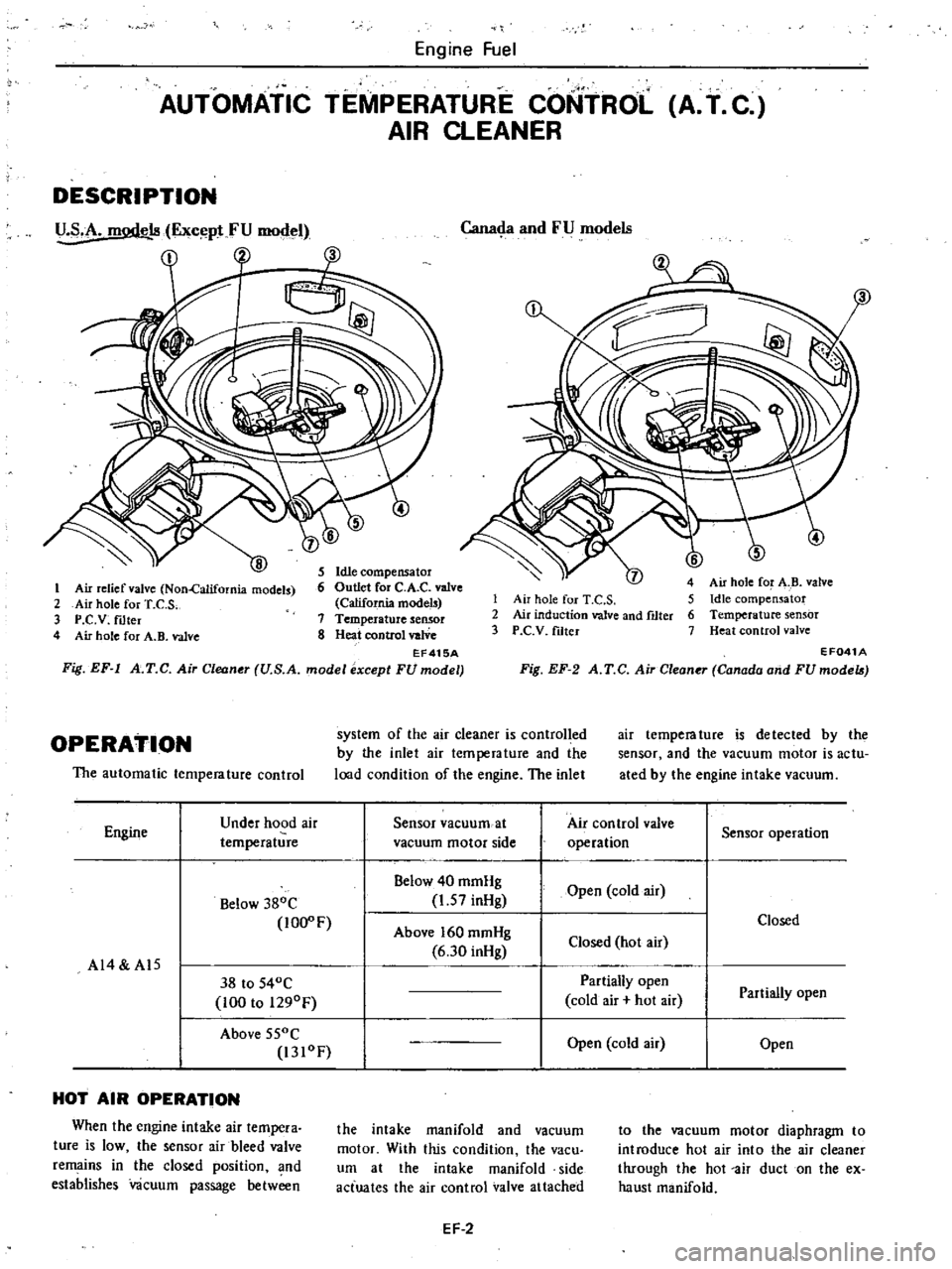
Engine
Fuel
AUTOMATIC
TEMPERATURE
COtirROL
A
T
C
AIR
CLEANER
DESCRIPTION
U
S
A
mode
18
ExC
FU
model
I
C1J
Cana
ia
and
FU
models
I
Air
relief
valve
Non
alifornia
models
2
Air
hole
for
T
C
S
3
P
C
V
mter
4
Air
hole
for
A
B
valve
5
Idle
compensator
6
Outlet
for
C
A
C
valve
California
model
7
Temperature
seIl50r
8
Heat
control
valVe
EF415A
Fig
EF
l
A
T
C
Air
Cleaner
U
S
A
model
except
FU
model
8
3
1
Air
hole
for
T
C
S
2
Air
induction
valve
and
ftIter
3
P
C
V
mtet
Air
hole
for
A
B
valve
Idle
compen
ator
Temperature
sensor
Heat
control
valve
EF041A
Fig
EF
2
A
T
C
Air
Cleaner
Canado
ond
FUmodel
The
automatic
temperature
control
system
of
the
air
cleaner
is
control
ed
by
the
inlet
air
temperature
and
the
load
condition
of
the
engine
The
inlet
air
temperature
is
detected
by
th
sensor
and
the
vacuum
motor
is
actu
ated
by
the
engine
intake
vacuum
OPERATION
Engine
Under
hood
air
temperature
Sensor
vacuum
at
vacuum
motor
side
Air
con
trol
valve
operation
Sensor
operation
Below
380e
IOO
F
Below
40
mmHg
1
57
inHg
Open
cold
air
AI4
A15
Above
160
mmHg
6
30
inHg
Closed
Closed
hot
air
38
to
S40C
100
to
l290F
Partially
open
cold
air
hot
air
Partially
open
Above
550e
1310F
Open
cold
air
Open
HOT
AIR
OPERATION
When
the
engine
intake
air
tempera
ture
is
low
the
sensor
air
bleed
valve
remains
in
the
closed
position
and
establishes
vacuum
passage
betw
n
the
intake
manifold
and
vacuum
motor
With
this
condition
the
vacu
um
at
the
intake
manifold
side
actuates
the
air
control
valve
attached
to
the
vacuum
motor
diaphragm
to
introduce
hot
air
into
the
air
cleaner
through
the
hot
air
duct
on
the
ex
haust
manifold
EF
2
Page 88 of 548
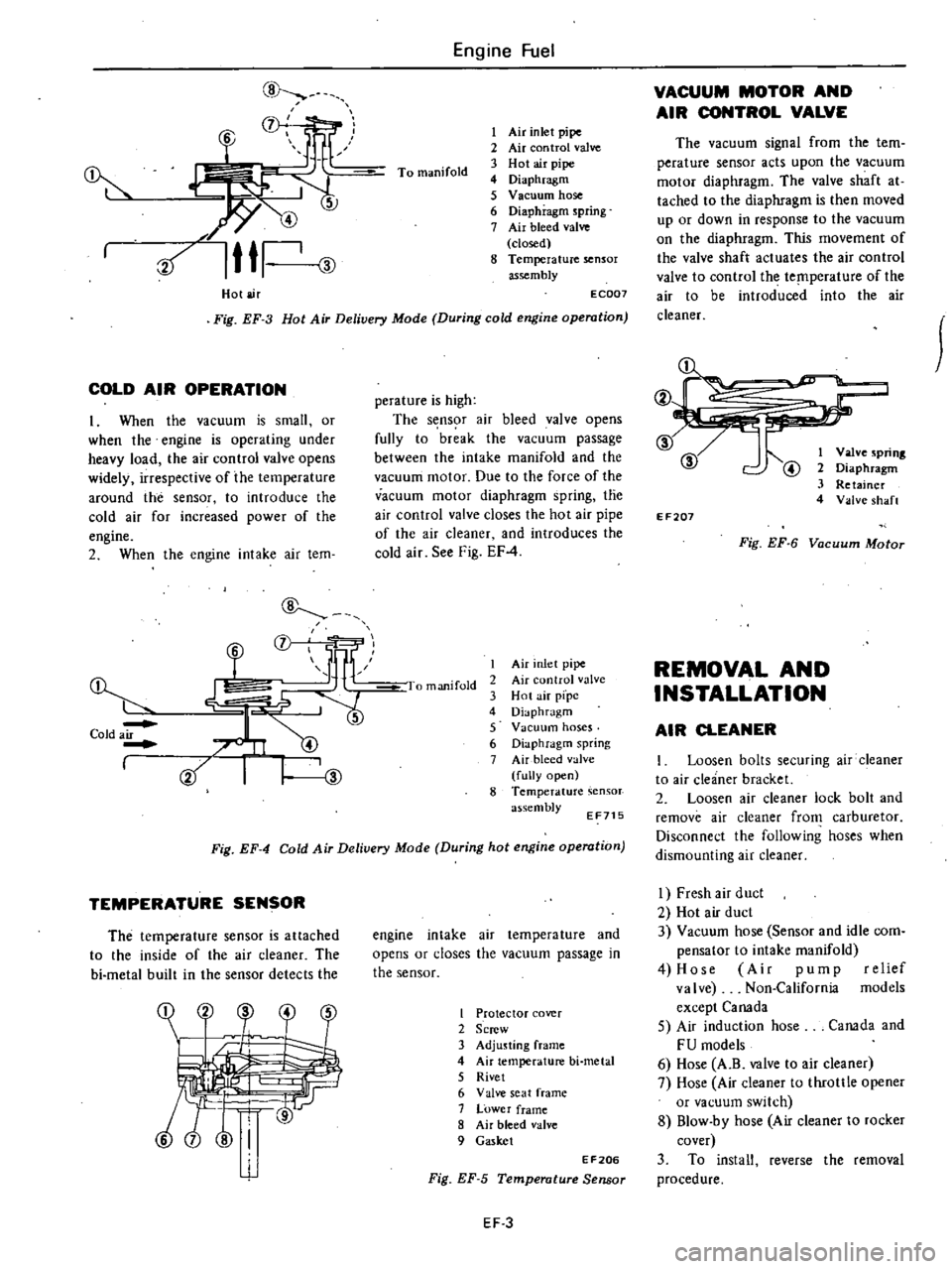
Hot
air
Engine
Fuel
To
manifold
I
Air
inlet
pipe
2
Air
con
trol
valve
3
Hot
air
pipe
4
Diaphragm
5
V
Bellum
hose
6
Diaphragm
spring
7
Air
bleed
valve
closed
8
Temperature
sensor
assembly
Fig
EF
3
Hot
Air
Delivery
Mode
During
cold
engine
operation
EC007
COLD
AIR
OPERATION
1
When
the
vacuum
is
small
or
when
the
engine
is
operating
under
heavy
load
the
air
control
valve
opens
widely
irrespective
of
the
temperature
around
the
sensor
to
introduce
the
cold
air
for
increased
power
of
the
engine
2
When
the
engine
intake
air
tem
Cold
air
I
L
CD
mf
LlF
JII
1
perature
is
high
The
s
ns
r
air
bleed
valve
opens
fully
to
break
the
vacuum
passage
between
the
intake
manifold
and
the
vacuum
motor
Due
to
the
force
of
the
vacuum
motor
diaphragm
spring
tne
air
control
valve
closes
the
hot
air
pipe
of
the
air
cleaner
and
introduces
the
cold
air
See
Fig
EF
4
I
manifold
I
Air
nlet
pipe
2
Air
control
valve
3
Hot
air
pfpc
4
Diaphragm
5
Vacuum
hoses
6
Diaphragm
spring
7
Air
bleed
alve
fully
open
8
Temperature
assembly
EF715
Fig
EF
4
Cold
Air
Deliuery
Mode
During
hot
engine
operation
TEMPERATURE
SENSOR
The
temperature
sensor
is
attached
to
the
inside
of
the
air
cleaner
The
bi
metal
built
in
the
sensor
detects
the
engine
intake
air
temperature
and
opens
or
closes
the
vacuum
passage
in
the
sensor
I
Protector
cover
2
Screw
3
Adjusting
frame
4
Air
temperature
bi
metal
5
Rivet
6
Valve
seat
frame
7
Lower
frame
8
Air
bleed
valve
9
Gasket
EF206
Fig
EF
5
Temperature
Sensor
EF
3
VACUUM
MOTOR
AND
AIR
CONTROL
VALVE
The
vacuum
signal
from
the
tem
perature
sensor
acts
upon
the
vacuum
motor
diaphragm
The
valve
shaft
at
tached
to
the
diaphragm
is
then
moved
up
or
down
in
response
to
the
vacuum
on
the
diaphragm
This
movement
of
the
valve
shaft
actuates
the
air
control
valve
to
control
the
temperature
of
the
air
to
be
introduced
into
the
air
cleaner
@
@
@
I
Valve
spring
2
Diaphragm
3
Retainer
4
Valve
shaft
EF207
Fig
EF
6
Vacuum
Motor
REMOVAL
AND
INSTALLATION
AIR
CLEANER
I
Loosen
bolts
securing
air
cleaner
to
air
cleaner
bracket
2
Loosen
air
cleaner
lock
bolt
and
remove
air
cleaner
from
carburetor
Disconnect
the
following
hoses
when
dismounting
air
cleaner
I
Fresh
air
duct
2
Hot
air
duct
3
Vacuum
hose
Sensor
and
idle
com
pensator
to
intake
manifold
4
Hose
Air
pump
relief
valve
Non
California
models
except
Canada
5
Air
induction
hose
Canada
and
FU
models
6
Hose
A
B
valve
to
air
cleaner
7
Hose
Air
cleaner
to
throttle
opener
or
vacuum
switch
8
Blow
by
hose
Air
cleaner
to
rocker
cover
3
To
install
reverse
the
removal
procedure
Page 89 of 548
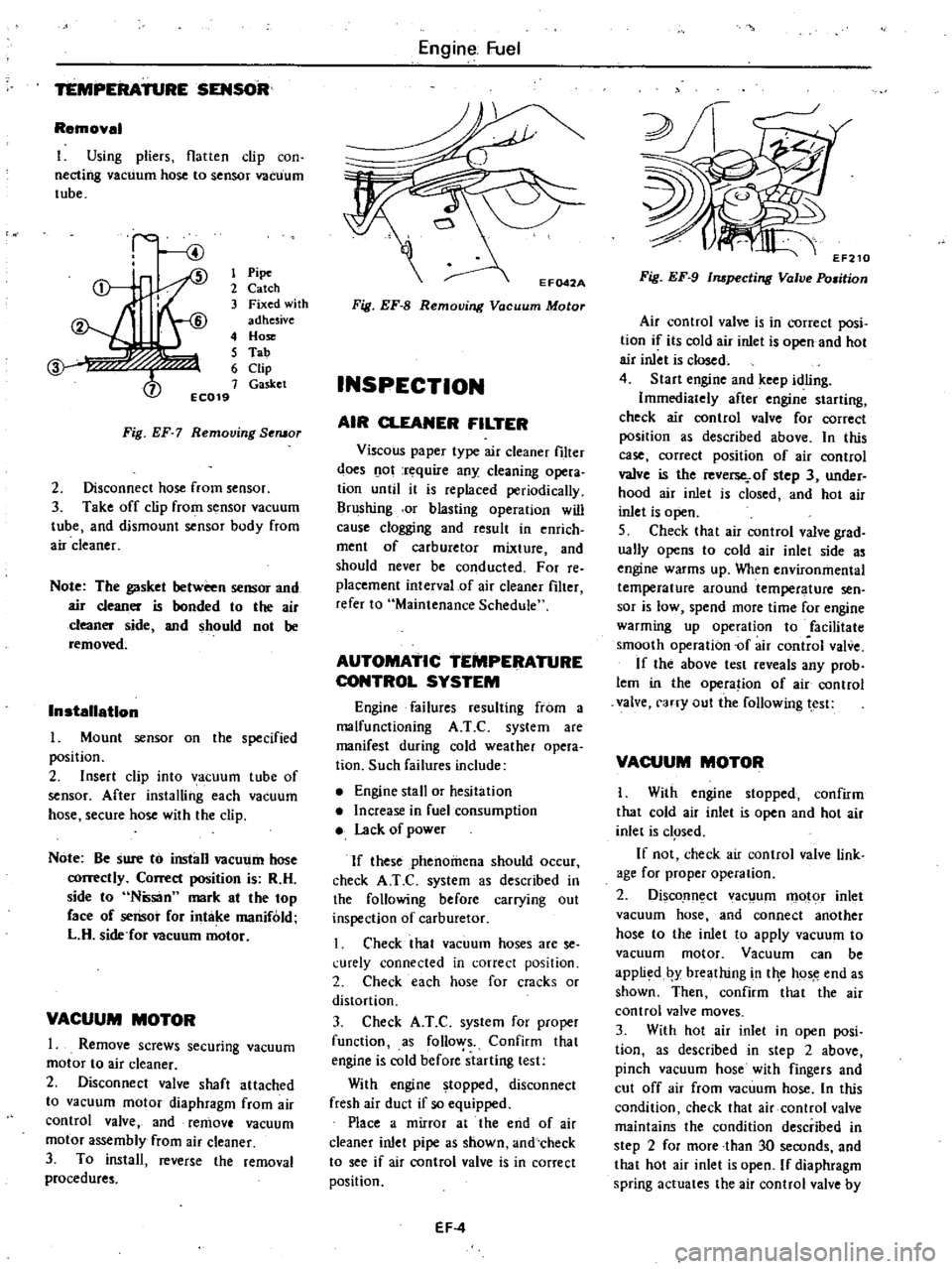
TEMPERATURE
SENSOR
Removal
I
Using
pliers
flatten
clip
con
necting
vacuum
hose
to
sensor
vacuum
tube
1
Pipe
2
Catch
3
Fixed
with
adhesive
4
Hose
5
Tab
6
Clip
7
Gasket
EC019
Fig
EF
7
Removing
Seruor
2
Disconnect
hose
from
sensor
3
Take
off
clip
from
sensor
vacuum
tube
and
dismount
sensor
body
from
air
cleaner
Note
The
gasket
between
sensor
and
air
cleaner
is
bonded
to
the
air
cleaner
side
and
should
not
be
removed
Installation
Mount
sensor
on
the
specified
position
2
Insert
clip
into
vacuum
tube
of
sensor
After
installing
each
vacuum
hose
secure
hose
with
the
clip
Note
Be
sure
to
install
vacUl
11n
hose
correctly
Correct
position
is
R
H
side
to
Ntisan
mark
at
the
top
face
of
sensor
for
intake
manifold
L
H
side
for
Deuum
motor
VACUUM
MOTOR
1
Remove
screws
securing
vacuum
motor
to
air
cleaner
2
Disconnect
valve
shaft
attached
to
vacuum
motor
diaphragm
from
air
control
valve
and
remove
vacuum
motor
assembly
from
air
cleaner
3
To
install
reverse
the
removal
procedures
Engine
Fuel
Fig
EF
8
Removing
Vacuum
Motor
INSPECTION
AIR
CLEANER
FILTER
Viscous
paper
type
air
cleaner
filter
does
o
ot
rt
quire
any
cleaning
opera
tion
until
it
is
replaced
periodically
Brushing
or
blasting
operation
will
cause
clogging
and
result
in
enrich
ment
of
carburetor
mixture
and
should
never
be
conducted
For
reo
placement
interval
of
air
cleaner
filter
refer
to
Maintenance
Schedule
AUTOMATIC
TEMPERATURE
CONTROL
SYSTEM
Engine
failures
resulting
from
a
malfunctioning
A
T
C
system
are
manifest
during
cold
weather
opera
tion
Such
failures
include
Engine
stall
or
hesitation
Increase
in
fuel
consumption
Lack
of
power
If
these
phenomena
should
occur
check
A
T
e
system
as
described
in
the
following
before
carrying
out
inspection
of
carburetor
I
Check
that
vacuum
hoses
are
se
l
urely
connected
in
correct
position
2
Check
each
hose
for
cracks
or
distortion
3
Check
A
T
C
system
for
proper
function
as
follo
ys
Confirm
that
engine
is
cold
before
starting
test
With
engine
topped
disconnect
fresh
air
duct
if
so
equipped
Place
a
mirror
at
the
end
of
air
cleaner
inlet
pipe
as
shown
and
check
to
see
if
air
control
valve
is
in
correct
position
EF
4
Fig
EF
9
Inspecting
Valve
Po
man
Air
control
valve
is
in
correct
posi
tion
if
its
cold
air
inlet
is
open
and
hot
air
inlet
is
closed
4
Start
engine
and
keep
idling
Immediately
after
engine
starting
check
air
control
valve
for
correct
position
as
described
above
In
this
case
correct
position
of
air
control
valve
is
the
reverse
of
step
3
under
hood
air
inlet
is
closed
and
hot
air
inlet
is
open
S
Check
that
air
control
valve
grad
ually
opens
to
cold
air
inlet
side
as
engine
warms
up
When
environmental
temperature
around
temperature
sen
sor
is
low
spend
more
time
for
engine
warming
up
operation
to
facilitate
smooth
operation
of
air
control
valve
If
the
above
test
reveals
any
prob
lem
in
the
opera
ion
of
air
control
valve
carry
out
the
following
test
VACUUM
MOTOR
I
With
engine
stopped
confirm
that
cold
air
inlet
is
open
and
hot
air
inlet
is
c1
Sed
If
not
check
air
control
valve
link
age
for
proper
operation
2
DiscoJln
ct
ac
um
motor
inlet
vacuum
hose
and
connect
another
hose
to
the
inlet
to
apply
vacuum
to
vacuum
motor
Vacuum
can
be
appli
d
by
breathing
in
tile
hos
e
end
as
shown
Then
confirm
that
the
air
control
valve
moves
3
With
hot
air
inlet
in
open
posi
tion
as
described
in
step
2
above
pinch
vacuum
hose
with
fingers
and
cut
off
air
from
vacuum
hose
In
this
condition
check
that
air
control
valve
maintains
the
condition
described
in
step
2
for
more
than
30
seconds
and
that
hot
air
inlet
is
open
If
diaphragm
spring
actuates
the
air
control
valve
by
Page 90 of 548
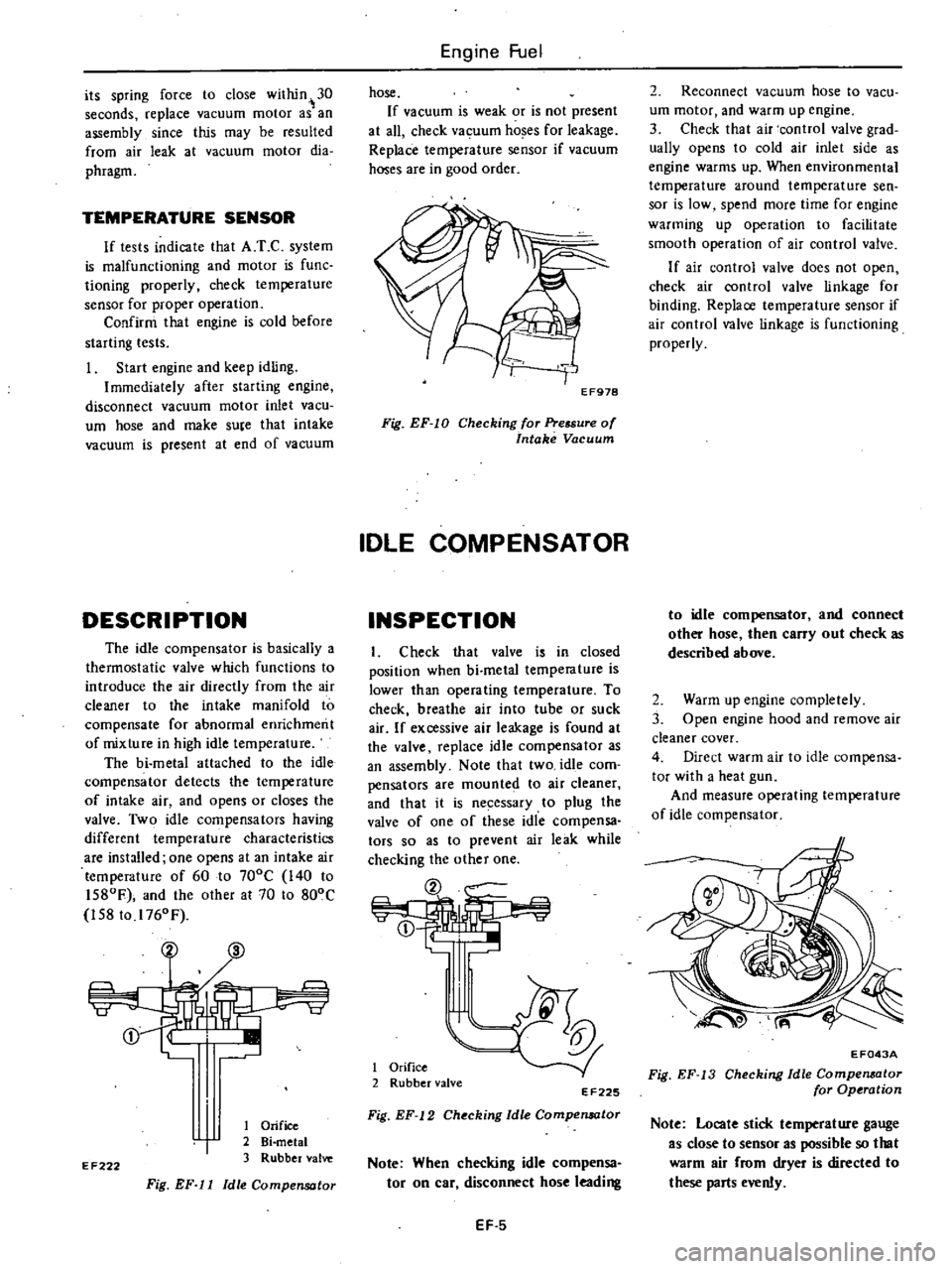
its
spring
force
to
close
within
30
seconds
replace
vacuum
motor
as
an
assembly
since
this
may
be
resulted
from
air
leak
at
vacuum
motor
dia
phragm
TEMPERATURE
SENSOR
If
tests
indicate
that
A
T
C
system
is
malfunctioning
and
motor
is
func
tioning
properly
check
temperature
sensor
for
proper
operation
Confirm
that
engine
is
cold
before
starting
tests
Start
engine
and
keep
idling
Immediately
after
starting
engine
disconnect
vacuum
motor
inlet
vacu
um
hose
and
make
suce
that
intake
vacuum
is
present
at
end
of
vacuum
DESCRIPTION
The
idle
compensator
is
basically
a
thermostatic
valve
which
functions
to
introduce
the
air
directly
from
the
air
cleaner
to
the
intake
manifold
to
compensate
for
abnormal
enrichmerit
of
mixture
in
high
idle
temperature
The
bi
metal
attached
to
the
idle
compensator
detects
the
temperature
of
intake
air
and
opens
or
closes
the
valve
Two
idle
compensators
having
different
temperature
characteristics
are
installed
one
opens
at
an
intake
air
temperature
of
60
to
700C
140
to
IS80F
and
the
other
at
70
to
800C
158
to
1760
F
EF222
1
Orifice
2
Bi
metal
3
Rubber
valve
Fig
EF
ll
Idle
Compensator
Engine
Fuel
hose
If
vacuum
is
weak
or
is
not
present
at
all
check
vacuum
hoses
for
leakage
Replace
temperature
sensor
if
vacuum
hoses
are
in
good
order
EF978
Fig
EF
l0
Checking
for
Pressure
of
Intake
Vacuum
IDLE
COMPENSATOR
INSPECTION
I
Check
that
valve
is
in
closed
position
when
bi
metal
temperature
is
lower
than
operating
temperature
To
check
breathe
air
into
tube
or
suck
air
If
excessive
air
leakage
is
found
at
the
valve
replace
idle
compensator
as
an
assembly
Note
that
two
idle
com
pensators
are
mounted
to
air
cleaner
and
that
it
is
ne
essary
to
plug
the
valve
of
one
of
these
idle
compensa
tors
so
as
to
prevent
air
leak
while
checking
the
other
one
I
t
I
I
Orifice
2
Rubber
valve
EF225
Fig
EF
12
Checking
Idle
Compensator
Note
When
checking
idle
compensa
tor
on
car
disconnect
hose
leading
EF
5
2
Reconnect
vacuum
hose
to
vacu
um
motor
and
warm
up
engine
3
Check
that
air
control
valve
grad
ually
opens
to
cold
air
inlet
side
as
engine
warms
up
When
environmental
temperature
around
temperature
sen
sor
is
low
spend
more
time
for
engine
warming
up
operation
to
facilitate
smooth
operation
of
air
control
valve
If
air
control
valve
does
not
open
check
air
control
valve
linkage
for
binding
Replace
temperature
sensor
if
air
control
valve
linkage
is
functioning
properly
to
idle
compensator
and
connect
other
hose
then
carry
out
check
as
described
above
2
Warm
up
engine
completely
3
Open
engine
hood
and
remove
air
cleaner
cover
4
Direct
warm
air
to
idle
compensa
tor
with
a
heat
gun
And
measure
operating
temperature
of
idle
compensator
EF043A
Fig
EF
13
Checking
Idle
Compemator
for
Op
ration
Note
Locate
stick
temperature
gauge
as
close
to
sensor
as
possible
so
that
warm
air
from
dryer
is
directed
to
these
parts
evenly
Page 121 of 548
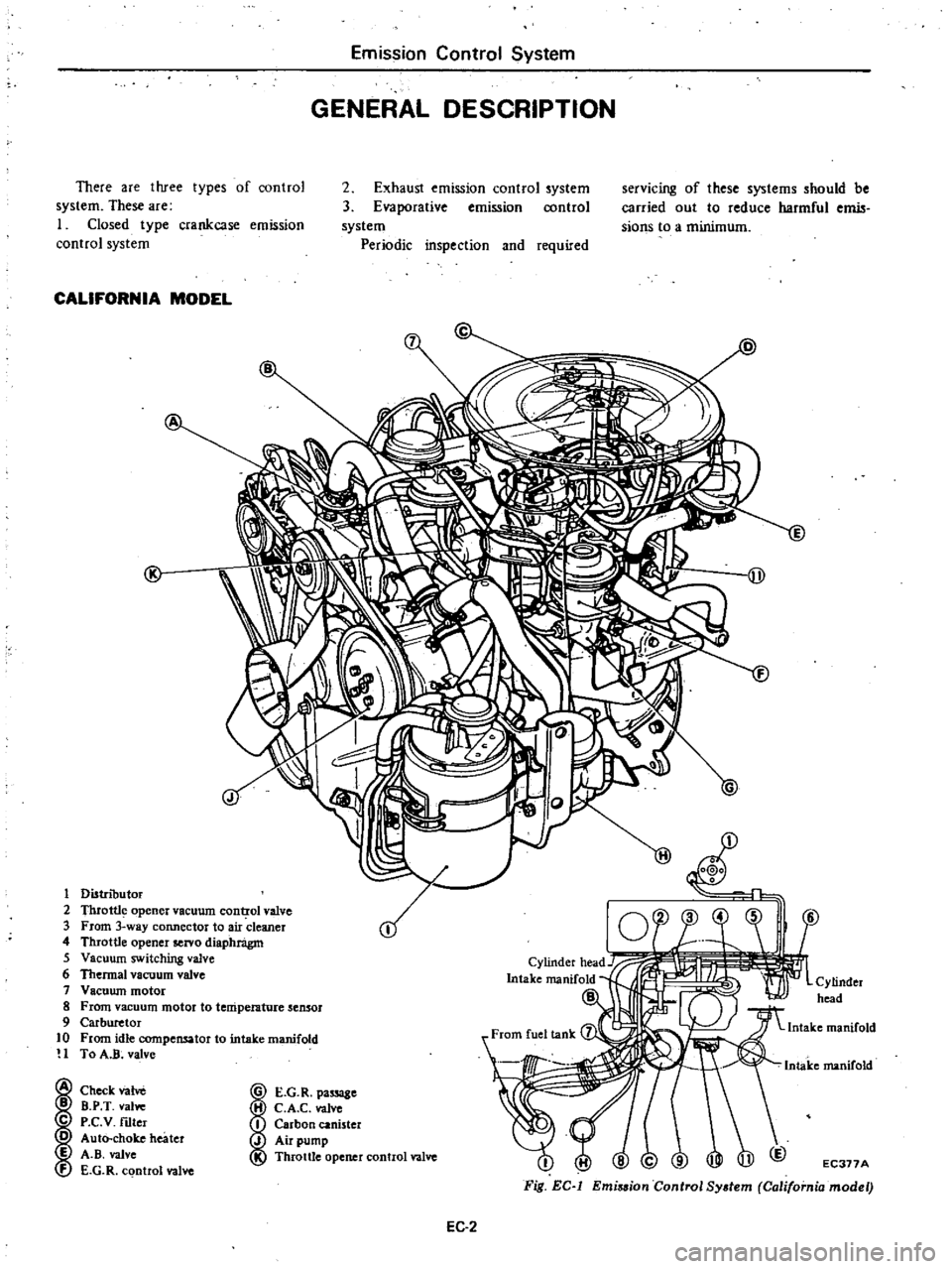
Emission
Control
System
GENERAL
DESCRIPTION
There
are
three
types
of
control
system
These
are
I
Closed
type
crankcase
emission
control
system
2
Exhaust
emISSIon
control
system
3
Evaporative
emission
control
system
Periodic
inspection
and
required
sefVIcmg
of
these
systems
should
be
carried
out
to
reduce
harmful
emis
sions
to
a
minimum
CALIFORNIA
MODEL
1
Distributor
2
Thrott1
opener
vacuum
cont
rol
valve
3
From
3
way
connector
to
air
cleaner
4
Throttle
opener
servo
diaphnigm
5
Vacuum
switching
valve
6
Thermal
vacuum
valve
7
Vacuwn
motor
8
From
vacuum
motor
to
temperature
sensor
9
Carburetor
10
From
idle
compensator
to
intake
manifold
H
To
A
R
valve
Check
vane
B
B
P
T
vallie
C
P
c
V
nIter
o
Auto
choke
heater
E
A
B
valve
f
E
G
R
control
valve
A
E
D
j
L
I
E
G
R
pa
8e
H
C
A
C
valve
I
Carbon
canister
J
Air
pump
Throttle
opener
control
valve
EC377A
Fig
EC
l
Emi
sion
Control
System
California
model
EC
2
Page 122 of 548
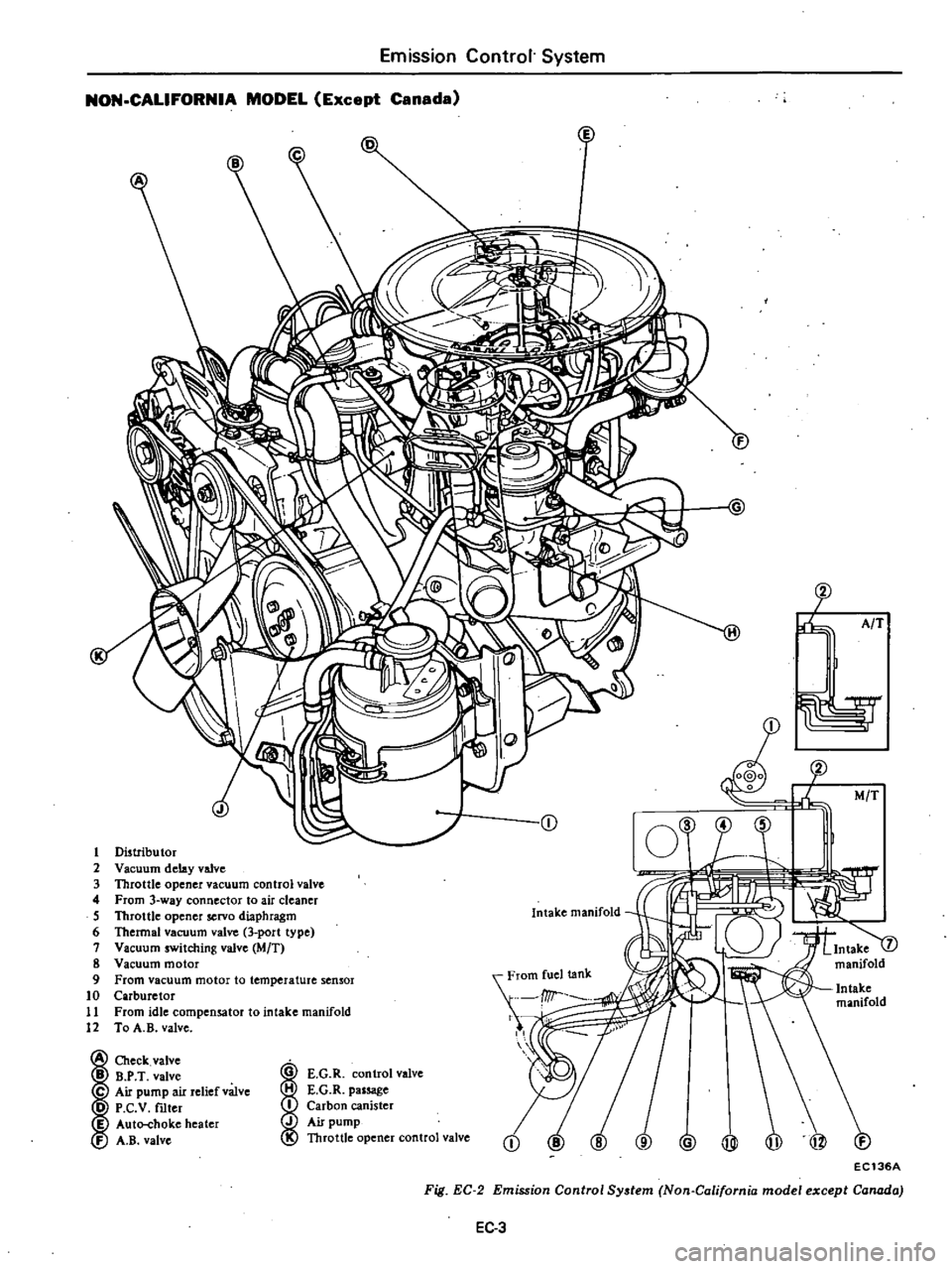
Emission
Control
System
NON
CALIFORNIA
MODEL
Except
Canada
5
CD
O@
j
l
t
AfT
M
T
1
Distributor
2
Vaellum
delay
valve
3
Throttle
opener
vacuum
control
valve
4
From
3
way
connector
to
air
cleaner
5
Throttle
opener
servo
diaphragm
6
Thermal
vacuum
valve
3
port
type
7
Vacuum
switching
valve
eMIT
8
Vacuum
motor
9
From
vacuum
motor
to
temperature
sensor
10
Carburetor
11
From
idle
compensator
to
intake
manifold
12
To
A
B
valve
rom
I
It
Intake
manifold
Check
valve
B
P
T
valve
C
Air
pump
air
relief
valve
D
P
C
V
mter
I
Auto
choke
heater
A
B
valve
I
E
G
R
control
valve
E
G
R
passage
Carbon
canister
Air
pump
Throttle
opener
control
valve
@
@
to
EC136A
Fig
EC
2
Emission
Control
System
Non
Californin
model
except
Canada
EC
3
Page 124 of 548
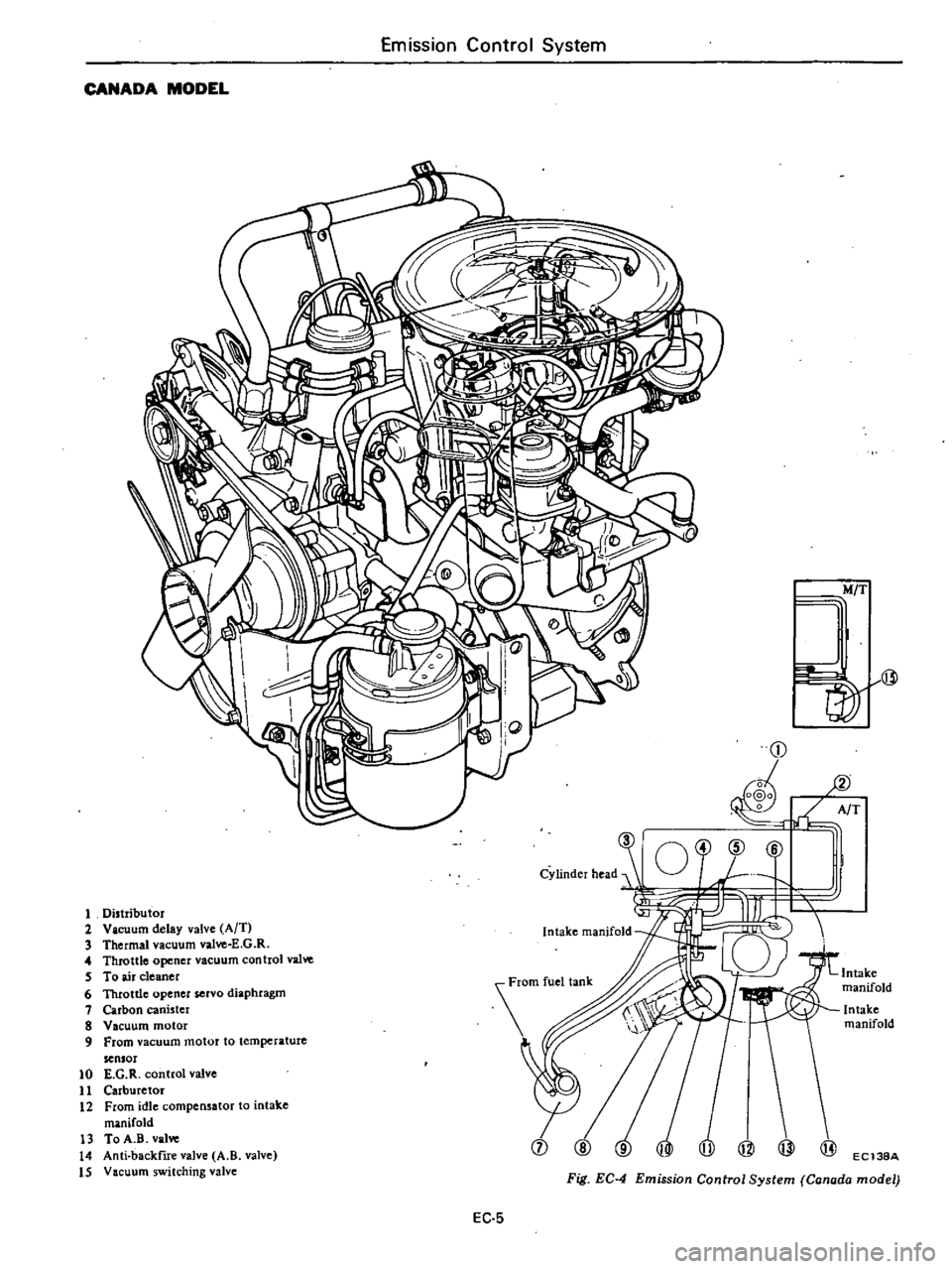
Emission
Control
System
CANADA
MODEL
1
Distributor
2
Vacuum
delay
valve
AfT
3
Thermal
vacuum
valve
E
G
R
4
Throttle
opener
vacuum
control
valve
S
To
air
cleaner
6
Throttle
opener
servo
diaphragm
7
Carbon
canister
8
Vacuum
motor
9
From
vacuum
motor
to
temperature
sensor
10
E
G
R
control
valve
11
Carburetor
12
From
idle
compensator
to
intake
manifold
13
To
A
B
valve
14
Anti
backltre
valve
A
B
valve
15
Vacuum
switching
valve
M
T
@
CD
ft
o@o
0
LA
T
CID
om
fuel
tank
Intake
manifold
Intake
manifold
@
It
Il
9
EC138A
Fig
EC
4
Emission
Control
System
Canada
model
EC
5